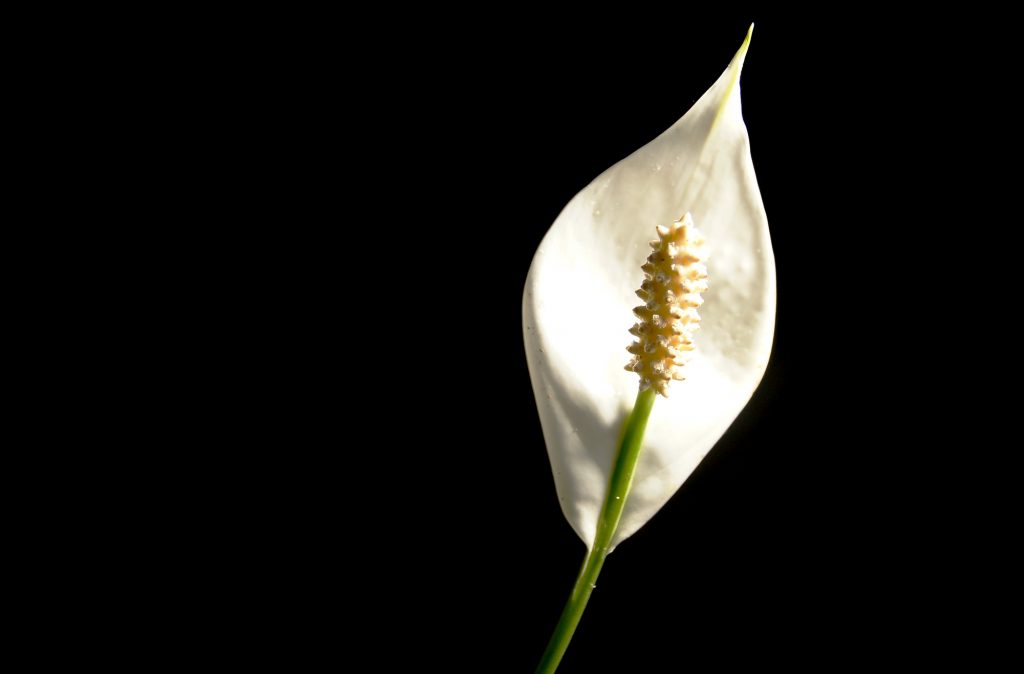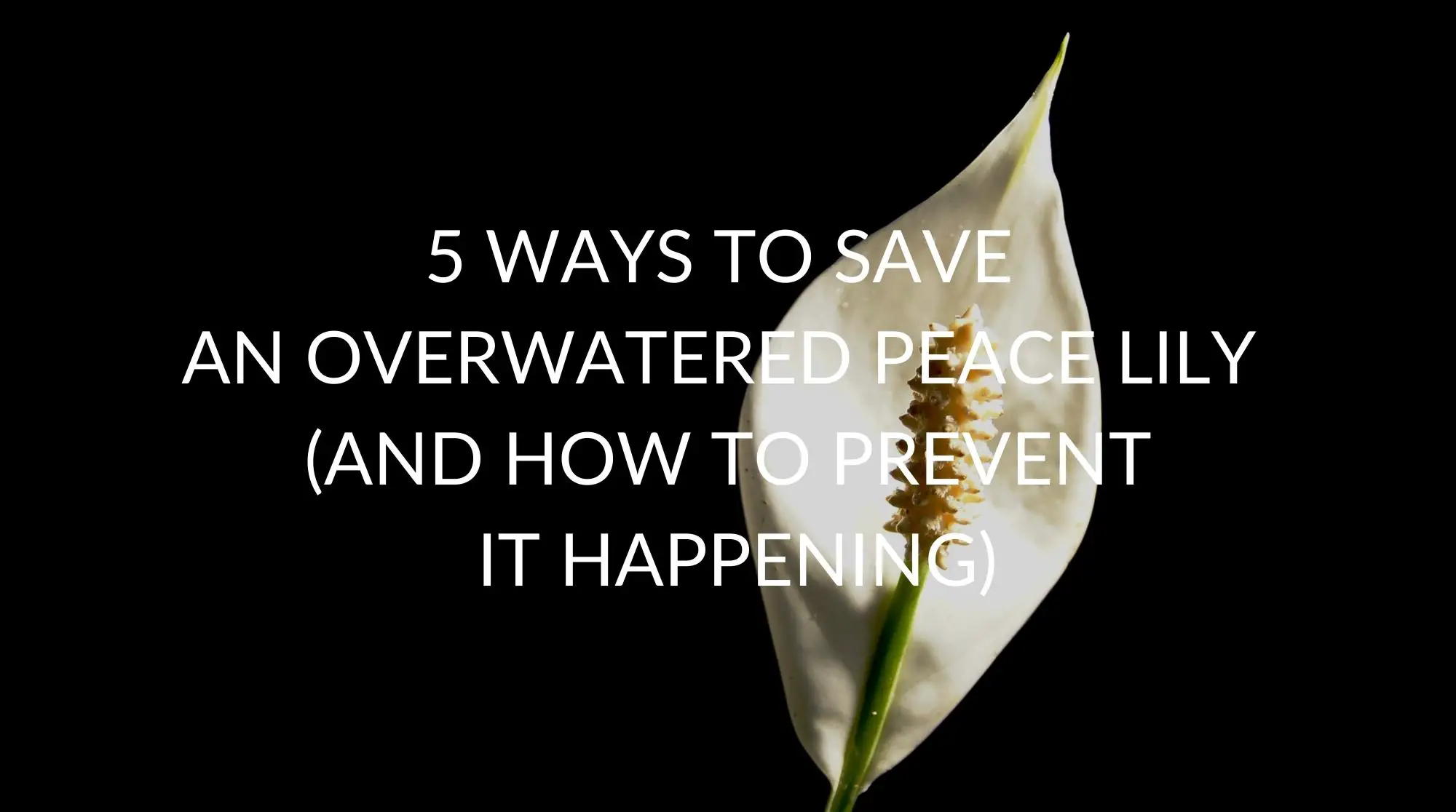Peace Lilies are popularly known as attractive, low-maintenance indoor plants. As a loving plant owner, you want the best care for your Peace Lily. At times, you may accidentally or intentionally give your plant too much water, thinking it will be happier.
But overwatering your peace lily does more harm than good and should be avoided at all costs. In this article, we will learn why it is a bad idea to overwater your Peace Lily, what you can do to help it recover, and what to do to prevent it.
So, keep reading to learn more!
Is It Bad To Overwater A Peace Lily Plant?
Unlike plants that thrive well in swampy regions, Peace Lilies are originally found in tropical regions where they get just enough water to survive. Since they are used to getting just the right amount of water, overwatering your Peace Lily can have some serious effects. Here are the reasons why it’s a bad idea to give your plant too much water:
It Cuts Off your Peace Lily’s Oxygen Supply
When you overwater your Peace Lily, the soil gets too much moisture or too soggy. This results in your plant struggling to get the oxygen that it needs to survive. Maintaining enough oxygen in your roots is crucial for the health and growth of your Peace Lily. When your soil gets too soggy, very minimal oxygen can be absorbed by your Peace Lily’s roots which can have a detrimental effect on its health.
It Can Cause Root Rot
If your Peace Lily’s soil is constantly getting boggy, the lack of oxygen supply to your Peace Lily’s roots can lead to root rot. Soggy soil makes it extra difficult for your plants to breathe properly and to function normally since they can’t absorb the nutrients properly. Sadly, this can lead to a bad case of root rot in your Peace Lily.
Your Peace Lily can Develop Fungal Diseases
Overwatering your Peace Lily can also damage its root system. When the root system gets damaged, the necessary nutrients like potassium as well as nitrogen can not be absorbed by your plant. As the health of your Peace Lily gets compromised, It can become susceptible to fungal infections such as:
- Leaf Blight
Phytophthora species, also known as water mold, are soil-inhabiting organisms that thrive in wet conditions. This can cause leaf blight to your plant. Your Peace lily may start developing leaf margins and brown or black dead spots in the middle.
- Cylindrocladium Root Rot
When your Peace Lily gets overwatered, it can be vulnerable to this infection. Cylindrocladium root rot is a fungal infection caused by Cylindrocladium spathiphyllum. Moisture can speed up the damage this can do to your plant, where it can progress from a couple of weeks to a few months.
Detecting the rot can be quite tricky. Your Peace Lily’s leaves may seem healthy for the first weeks of root rot until the signs of infection start to show. As you notice the dark brown spots start to appear in your leaves, the damage to your peace lily has already developed substantially.
- Pythium Root Rot
For the Pythium root rot, another water mold called Pythium spp is to blame. When your Peace Lily gets this type of fungal infection, its roots will turn black and mushy, and your leaves will wilt and turn yellow. Severe infection can lead to the death of your Peace Lily.

Signs of Overwatered Peace Lily
Overwatering your peace lily causes it to show several symptoms, and it is absolutely necessary that you take immediate actions once they start appearing.
Roots
After overwatering your Peace Lily, the problems will start to appear from beneath the soil.
As your roots get impaled by too much moisture, they won’t be able to do their job in absorbing oxygen, nutrients, and minerals necessary to keep your Peace Lily healthy.
Your Peace Lily’s roots will appear wet and mushy. If you have been overwatering it for quite some time, you may also notice a rotting smell coming from your roots. This is mainly because root rot can start to set in.
Leaves
The leaves would turn pale and yellow, starting from the bottom leaves to the top. If you continue overwatering your Peace Lily, small water blisters called leaf edemas may also start to appear.
If you don’t take action at this point, your leaves can develop black or brown tips, and your plant can be more susceptible to fungal infections, as mentioned above. Black, brown or yellow spots will show, and your Peace Lily will slowly wither and droop. You might also see some mold in your soil.
Overwatering vs. Underwatering
Determining whether your Peace Lily is showing signs of overwatering or underwatering can be quite tricky. So, here’s a quick comparison of the symptoms to look out for if you’re unsure whether you Peace Lily’s overwatered or underwatered.
| Signs of Overwatered Peace Lily | Signs of Underwatered Peace Lily |
| Wet and Soggy Soil | Dry topsoil for 1-2 inches |
| Leaves turning pale and Yellow | Dry and crispy leaves |
| Roots turning wet and mushy | Roots getting dry |
| Small water blisters on the leaves | Brown spots appearing on the leaves |
| Roots turning black and getting weaker | Roots getting brittle |
Factors That Increase The Risk Of Overwatering Your Peace Lily
No matter how meticulous of a plant owner you are, there will always be situations where the risks of overwatering your Peace Lily increase, whether it’s intentional or not. Let’s check them out:
Pot Material
Non-absorbing plant pots made from metal and plastic are less effective in absorbing moisture when you water your Peace Lily. So, instead of using these types of pots, consider using pots made from porous materials such as wood, clay, or timber. These types of pots allow air to move and circulate around plant roots.
Pot Size
If you have a small Peace Lily planted in a pot that’s too big, the risks of overwatering increase. This is because bigger pots with more soil volume will take longer to dry up, and this can lead to excessively moist soil, which is bad for your plant.
Poor Drainage
Even though you have the right pot size, your Peace Lily can still be at risk of being overwatered if your pots have poor drainage. So, make sure that your pots have proper drainage holes for air circulation and that your drip trays are not filled with water.
Seasons and Temperature
If you live in areas with very cold winter seasons, chances are your Peace Lilies will be at higher risk of getting too much water due to the reduced transpiration in cold temperatures. If your soil doesn’t get enough airflow, it is more likely that it will take a longer time for it to dry out. If you live in a tropical region, however, you may be tempted to water your Peace Lily several times a day out of pity, thinking that it needs way too much water due to the heat.
Therefore, it is critical for Peace Lily owners to know how much water their plant really needs depending on the season and temperature.
Watering Too Much
Although it seems pretty obvious, many people forget the simple fact that their Peace Lilies do not need too much water to thrive. Instead of following a strict watering schedule for your Peace Lily, you should give it water only after examining whether the top half of the soil is already dry enough.
How to Save Overwatered Lily Plant
Once your Peace Lily starts showing the signs of Overwatering, it is absolutely important that you take immediate steps to revive your plant. The longer time you delay taking action, the less likely your Peace Lily will survive. But, your Peace Lily isn’t a lost cause, so don’t lose hope! Here are some things you can do to save your overwatered Peace Lily:
Refrain from Watering Your Peace Lily
Due to obvious reasons, your Peace Lily has taken way too much water than it really needs. Giving your plant more water will make the situation worse.
Remove Your Peace Lily From Its Pot
Instead of simply waiting for your current soil to drain, consider removing your Peace Lily from its pot. Carefully take your Peace Lily out of its pot, and avoid breaking its brittle roots.
Cut Off The Infected Parts
Examine the roots and leaves of your Peace Lily. If you notice brown dead parts of the root, cut it off to prevent spreading. The same thing is to be done with yellow or brown leaves, including those that are wilting.
Treating the Affected Roots
Since overwatering mainly affects your Peace Lily’s roots, it is crucial that you treat this part of your plant. You may apply activated charcoal on the parts of the root that have been cut. You may also use weak solutions of chemicals such as thiophanate methyl, potassium permanganate, or other types of mild fungicides if you notice that root rot caused by fungal infections has set in.
After applying treatment to your Peace Lily, let it sit and dry for two to three hours before the next step.
Repot Your Peace Lily
Planting your Peace Lily in a new pot helps to allow recovery and prevent further re-infection. Use a well-drained soil mix in repotting.
The pot to be used can be the same size as the last one, or you can use the next size up. However, do not make the mistake of using an oversized pot for a small Peace Lily, as it can increase the likelihood of getting your newly revived Peace Lily being overwatered again.
Mix activated carbon with your soil, or add one-third of perlite to promote better drainage. Since you will be using slightly moist soil in repotting your Peace Lily, there’s no need to water it until your plant finally settles in its new soil. Wait for a few days before re-watering your Peace Lily.
After carefully applying all the tips above in reviving your waterlogged Peace Lily, you should see it slowly recovering its yellowish droopy leaves to green, healthy ones. The overall timeline for this recovery can take about two to three weeks. Since this recuperation happens gradually, be patient. Your Peace Lily will get better in no time.
How To Prevent Overwatering In Peace Lilies
As the saying goes, prevention is always better than cure. This is especially true when it comes to taking care of your Peace Lily. Instead of taking chances and simply wishing that you don’t overwater your plant, here are some helpful tips that you can try to prevent it from happening.
Watering Your Peace Lily
Peace Lilies are natives from tropical regions of the world, and they are used to getting their water and nutrients from the rich, damp soil of the rainforests. Therefore, they do not need excess watering because this can harm them.
The required frequency of watering your Peace Lily is affected by many things. A once-a-week schedule in watering works best for some, while others do it every 3-4 days.
Your Peace Lily’s watering needs depend on several factors such as its size, the varying seasons and temperature, and what growth stage your plant is in.
The more leaves your Peace Lily has, the more water it needs, but NEVER too much. This also applies if your plant is in its blooming or growing stage, where they need more water than usual. Make sure that you give your plant an adequate amount of water only when they need it.
So, how will you determine that your Peace Lily needs some good ‘ol watering? The simplest way to know this is to poke your finger into the soil. If your Peace Lily is in a small pot, the first 1-2 inches should be dry before watering. If you have a pot that’s bigger than 15 centimeters, then you have to make sure that the top of the soil is dry before re-watering.
Also, avoid watering your Peace Lily at night! The many hours that your plant spends in boggy soil without proper ventilation and limited transpiration can also lead to infections.
Seasons
Watering your Peace Lily in different seasons can be quite tricky. In summer, evaporation and transpiration take place much faster, so you may need to water it more often, provided that you examined the soil beforehand. Your Peace Lily’s leaves will also start to droop as a sign that it is ready for some of that H2O.
In winter days, when evaporation happens more slowly, watering your Peace Lily every two weeks is enough to keep it healthy.
Ensure Proper Drainage
Once you have repotted your Peace Lily, make sure that your plant pot has the proper drain holes to avoid the same overwatering fiasco from happening again. This step is crucial because there may be situations where you might lose track of how much you’ve been watering your Peace Lily, and having unobstructed drainage holes will help avoid too much moisture in your soil.
Along with proper drainage holes, it is also important to keep your drip trays empty in order to avoid water stagnation.
Proper Lighting
Your Peace Lily requires indirect sunlight for it to thrive, similar to its native habitat where it receives dappled sunlight under the rainforest trees. Placing your plant directly under the sunshine can cause sunburn, damaging your plant. It can also lead to stunted growth, and your Peace Lily will suffer in the long run.
So, instead of giving your Peace Lily a sunbath, place it under a shade where it can still receive indirect sunlight, whether indoors or outdoors.
Fertilizer
During the recovery period of your Peace Lily, one might think that feeding it with a lot of fertilizer will fasten the process, but this is not the case. In fact, giving fertilizer to your Peace Lily can put it under a lot of stress. Thus, it should be avoided as much as possible.
So, instead of fertilizing your Peace Lily after repotting, the best choice is to wait for at least 3 months before returning to your regular feeding routine.
Recap
Although you may want to give your Peace Lilies too much water to make sure that it doesn’t get thirsty, we learned today that this could actually be damaging to your plant for many reasons.
But when your Peace Lilies get overwatered and start showing symptoms of it, there’s no need to panic. There are practical ways you can do to revive your plant. By removing your plant from its pot, giving it the right treatment, and placing it in the right environment, you can help your Peace Lily to recover from overwatering.
But the best way to ensure that you’re giving your Peace Lily the right care is by knowing the risks of having it overwatered and acting upon what you have learned from this article.
Remember, giving your Peace Lily too much water can be damaging, but giving it the right amount of love can make it thrive!
If you liked this article, make sure you check out the rest of the website! Otherwise, have a great day!








